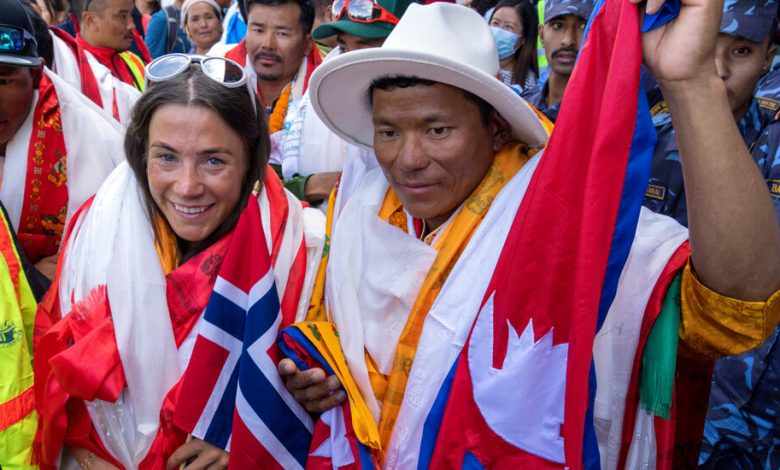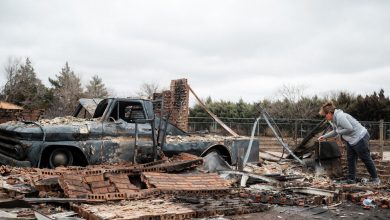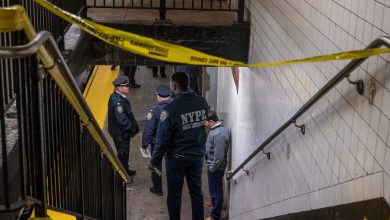K2 Climbers Criticized Over Continuing Ascent After Finding Dying Porter

A Norwegian climber defended her decision to continue a record-breaking series of climbs last month after encountering an injured porter who later died during her ascent of K2, the second-highest mountain in the world.
The climber, Kristin Harila, became one of the two fastest people — along with her guide, Tenjin Sherpa — to ascend all 14 of the world’s 8,000-meter mountains in three months and just under a day, surpassing what was already considered an exceptional record of six months and six days set by the Nepalese climber Nirmal Purja in 2019.
But two other climbers who were on the mountain on that day, July 27, said that Ms. Harila, her team and other climbers ignored an injured man — Muhammad Hassan, a 27-year-old father of three from Pakistan — because they wanted to reach the summit rather than abandon their climb to attempt a rescue.
Mr. Hassan fell from a particularly dangerous stretch of the climbing trail on K2 known as the bottleneck and later died.
“There was no rescue mission,” Wilhelm Steindl, an Austrian climber who provided video footage of other climbers stepping over Mr. Hassan on the narrow mountain path, said in an interview with Sky News. “Seventy mountaineers stepped over a living guy who needed big help at this moment, and they decided to keep on going to the summit.”
The authorities in Pakistan’s Gilgit-Baltistan region, where a portion of the mountain is located, identified Mr. Hassan as a “high-altitude porter.” They said they were investigating whether “adequate efforts were made to rescue” Mr. Hassan, whom Ms. Harila said was part of another team.
The authorities said they would examine the conditions of Mr. Hassan’s climbing gear and “ascertain who authorized him to climb with equipment that might have been insufficient for such high-altitude expeditions and his level of experience.”
People frequently die summiting the tallest mountains in the world, including Mount Everest and K2. The treks are so dangerous that the bodies of fallen climbers are sometimes left behind, and some are never recovered.
Weather conditions on K2 the day of Mr. Hassan’s death were so severe that many climbers, including Mr. Steindl, turned back.
In an interview with The Associated Press, Mr. Steindl said that Mr. Hassan could have been saved if Ms. Harila and others had abandoned their climb.
“There is a double standard here,” Mr. Steindl said. “If I, or any other Westerner, had been lying there, everything would have been done to save them. Everyone would have had to turn back to bring the injured person back down to the valley.”
Ms. Harila said in a statement on her website that she and her team did everything they could to save Mr. Hassan. She added that “it is truly tragic what happened, and I feel very strongly for the family.”
Ms. Harila said she and her team spent hours trying to rescue Mr. Hassan after discovering him hanging upside down from a rope after he had fallen off the cliff.
Ms. Harila also said that Mr. Hassan seemed to be “not properly equipped” to climb the 28,251-foot tall mountain, noting that he had no gloves, no oxygen mask and no down suit when they found him.
In Ms. Harila’s account, a group of Sherpas ahead of them told her that they were turning around, and “as we understood it that meant there was more help going to Hassan.”
Another member of Ms. Harila’s team who helped to pull Mr. Hassan back on the trail gave him his own oxygen, Ms. Harila said, and stayed with him until the team member himself began to run out of oxygen.
“We decided to continue forward as too many people in the bottleneck would make it more dangerous for a rescue,” she said. “Considering the amount of people that stayed behind and that had turned around, I believed Hassan would be getting all the help he could, and that he would be able to get down.”
She added that her team passed Mr. Hassan again on the way down. By then, he was dead but her team was “in no shape” to recover the body, she said.
“You need six people to carry a person down, especially in dangerous areas,” Ms. Harila said. “However, the bottleneck is so narrow that you can only fit one person in front and one behind the person being helped. In this case, it was impossible to safely carry Hassan down.”
Experienced mountaineers have complained in recent years that overcrowded mountain paths in Nepal — with too many inexperienced climbers — have contributed to avoidable deaths.
Climbing guides are also increasingly leaving the industry, driven off by the dangers of the job and a scant safety net for the families of those guides who die or who are left disabled.
In June, Gelje Sherpa and other guides rescued a Malaysian climber on Mount Everest at an elevation nearly as high as K2’s peak, abandoning their own climb and taking turns carrying the climber back to camp in a five-hour descent.





